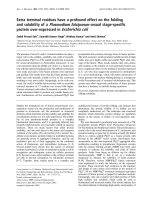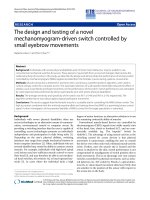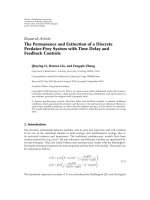IBM the rise and fall and reinvention of a global icon
Bạn đang xem bản rút gọn của tài liệu. Xem và tải ngay bản đầy đủ của tài liệu tại đây (30.12 MB, 670 trang )
HistoryofComputing
WilliamAsprayandThomasJ.Misa,editors
JanetAbbate,GenderintheHistoryofComputing:ReimaginingExpertise,Opportunity,andAchievement
throughWomen’sLives
JohnAgar,TheGovernmentMachine:ARevolutionaryHistoryoftheComputer
WilliamAspray,JohnvonNeumannandtheOriginsofModernComputing
WilliamAsprayandPaulE.Ceruzzi,TheInternetandAmericanBusiness
CharlesJ.Bashe,LyleR.Johnson,JohnH.Palmer,andEmersonW.Pugh,IBM’sEarlyComputers
Martin Campbell-Kelly, From Airline Reservations to Sonic the Hedgehog: A History of the Software
Industry
PaulE.Ceruzzi,AHistoryofModernComputing
I.BernardCohen,HowardAiken:PortraitofaComputerPioneer
I.BernardCohenandGregoryW.Welch,editors,Makin’Numbers:HowardAikenandtheComputer
JamesW.Cortada,IBM:TheRiseandFallandReinventionofaGlobalIcon
Thomas Haigh, Mark Priestley, and Crispin Rope, ENIAC in Action: Making and Remaking the Modern
Computer
JohnHendry,InnovatingforFailure:GovernmentPolicyandtheEarlyBritishComputerIndustry
MarieHicks,ProgrammedInequality:HowBritainDiscardedWomenTechnologistsandLostItsEdgein
Computing
Michael Lindgren, Glory and Failure: The Difference Engines of Johann Müller, Charles Babbage, and
GeorgandEdvardScheutz
DavidE.Lundstrom,AFewGoodMenfromUnivac
RenéMoreau,TheComputerComesofAge:ThePeople,theHardware,andtheSoftware
ArthurL.Norberg,ComputersandCommerce:AStudyofTechnologyandManagementatEckert-Mauchly
ComputerCompany,EngineeringResearchAssociates,andRemingtonRand,1946–1957
EmersonW.Pugh,BuildingIBM:ShapinganIndustryandItsTechnology
EmersonW.Pugh,MemoriesThatShapedanIndustry
EmersonW.Pugh,LyleR.Johnson,andJohnH.Palmer,IBM’s360andEarly370Systems
Kent C. Redmond and Thomas M. Smith, From Whirlwind to MITRE: The R&D Story of the SAGE Air
DefenseComputer
RaúlRojasandUlfHashagen,editors,TheFirstComputers—HistoryandArchitectures
Alex Roland with Philip Shiman, Strategic Computing: DARPA and the Quest for Machine Intelligence,
1983–1993
DineshC.Sharma,TheOutsourcer:AComprehensiveHistoryofIndia’sITRevolution
DorothyStein,Ada:ALifeandaLegacy
JohnVardalas,TheComputerRevolutioninCanada:BuildingNationalTechnologicalCompetence,1945–
1980
MauriceV.Wilkes,MemoirsofaComputerPioneer
JeffreyR.Yost,MakingITWork:AHistoryoftheComputerServicesIndustry
IBM
TheRiseandFallandReinventionofaGlobal
Icon
JAMESW.CORTADA
TheMITPress
Cambridge,Massachusetts
London,England
©2019MassachusettsInstituteofTechnology
Allrightsreserved.Nopartofthisbookmaybereproducedinanyformbyanyelectronicormechanical
means (including photocopying, recording, or information storage and retrieval) without permission in
writingfromthepublisher.
This book was set in Adobe Garamond Pro and Berthold Akzidenz Grotesk by Westchester Publishing
Services.PrintedandboundintheUnitedStatesofAmerica.
LibraryofCongressCataloging-in-PublicationData
Names:Cortada,JamesW.,author.
Title:IBM:theriseandfallandreinventionofaglobalicon/JamesW.Cortada.
Description: Cambridge, MA : The MIT Press, [2019] | Series: History of computing | Includes
bibliographicalreferencesandindex.
Identifiers:LCCN2018023090|ISBN9780262039444(hardcover:alk.paper)
Subjects: LCSH: International Business Machines Corporation—History. | Computer industry—United
States—History.
Classification:LCCHD9696.2.U6C672019|DDC338.7/61004—dc23
LCrecordavailableat />
ToIBMers,customers,andhistorianswhotaughtmewhatIknowaboutIBM
Contents
Preface
I FromBirthtoIdentity:IBMinItsEarlyYears,1880s–1945
1 Origins,1880s–1914
2 ThomasJ.WatsonSr.andtheCreationofIBM,1914–1924
3 TheEmergenceofIBMandtheCultureofTHINK
4 IBMandtheGreatDepression
5 IBMinWorldWarII,1939–1945
II IBMtheComputerBehemoth,1945–1985
6 IBMGetsintotheComputerBusiness,1945–1964
7 HowCustomers,IBM,andaNewIndustryEvolved,1945–1964
8 System360:OneoftheGreatestProductsinHistory?
9 “TheIBMWay”:HowItWorked,1964–1993
10 “TheIBMWay”:WhattheWorldSaw,1964–1993
11 IBMontheGlobalStage
12 TwoDecadesofAntitrustSuits,1960s–1980s
13 CommunistComputers
14 “AToolforModernTimes”:IBMandthePersonalComputer
III ATimeofCrisis,1985–1994
15 Storms,Crisis,andNearDeath,1985–1993
16 IBM’sInitialResponse,1985–1993
17 HowIBMWasRescued,1993–1994
IV IBMintheNewCentury
18 ANewIBM,1995–2012
19 HardTimes,Again,andAnotherTransformation
20 THINK:IBMTodayandItsLegacy
Author’sNote:IntheSpiritofTransparency
BibliographicEssay
Index
ListofFigures
Figure1.1
Charles Flint was highly creative in forming new stock-holding companies, including C-T-R, the
coreofthefutureInternationalBusinessMachinesCorporation.PhotocourtesyofIBMCorporate
Archives.
Figure1.2
Tabulatingmachine.HermanHollerith’smachineswereusedbyU.S.andEuropeancensustakers
andcompaniesinthe1890sandearly1900s.Theywereconsideredthemostsophisticateddata
processingequipmentoftheirday.PhotocourtesyofIBMCorporateArchives.
Figure1.3
HermanHollerith,inventorofthetabulatingequipmentusedbygovernmentsandcorporationsfor
halfacentury.PhotocourtesyofIBMCorporateArchives.
Figure1.4
Thomas J. Watson Sr. in his 40s, when he had taken over C-T-R to shape it into IBM. Photo
courtesyofIBMCorporateArchives.
Figure2.1
John H. Patterson was the creator of NCR and had a reputation for being an innovative and
successfulexecutive.PhotocourtesyofIBMCorporateArchives.
Figure2.2
An early branch office (1927), this one located in Washington, D.C., with its staff. These offices
wereacombinationretailoutletandtrainingcenter.PhotocourtesyofIBMCorporateArchives.
Figure2.3
NumberofC-T-Rbranchopenings,1914–1924.
Figure3.1
C-T-R/IBMhadonlytwologosuntiltheendofthe1940s.TheIBMlogodidnotbecomeahighly
recognizedimageuntilthelate1940s,althoughitwasrespectedearlierbyitscustomers.Photo
courtesyofIBMCorporateArchives.
Figure3.2
TheIBMType405wassoldasa“system,”notasoneproduct,andwasintroducedjustasIBM’s
customers’ volume and complexity of work expanded dramatically. Photo courtesy of IBM
CorporateArchives.
Figure4.1
The U.S. government became a massive user of IBM punch cards beginning in the 1930s in
supportoftheSocialSecurityAct.PhotocourtesyofIBMCorporateArchives.
Figure4.2
The IBM exhibit at the New York World’s Fair, 1939–1940. Photo courtesy of IBM Corporate
Archives.
Figure5.1
IBM Mark I. This system gave IBM engineers exposure to the possibilities of advanced
electronics. It was the largest calculator built in the United States before the arrival of the
computer.PhotocourtesyofIBMCorporateArchives.
Figure5.2
IBM604.ThesuccessoftheIBM604convincedmanyexecutivesthatadvancedelectronicswas
thewaveofthefuture,includingThomasWatsonJr.,whowouldleadthechargeintocomputing.
PhotocourtesyofIBMCorporateArchives.
Figure5.3
ArthurWatsoninuniform.ArthuristhelesserknownoftheWatsonboys.Itwasduringhismilitary
servicethathe,likehisbrother,maturedbeforeassumingsignificantresponsibilitiesatIBM.Photo
courtesyofIBMCorporateArchives.
Figure6.1
TheIBM704computerestablishedIBMasaserioussupplierofdigitalcomputingforcommercial
users,suggestingthatbusinessuseswouldexpand.PhotocourtesyofIBMCorporateArchives.
Figure6.2
IBM’s 650 computer was its most successful data processing product of the late 1950s. Massproduced and widely accepted by customers, it solidified IBM’s lead in the computer industry.
PhotocourtesyofIBMCorporateArchives.
Figure6.3
TheIBM305DiskStorageUnitmadeitpossiblefordataprocessinguserstoaccessdatadirectly,
making online systems possible in the 1960s. The device was also known as RAMAC. Photo
courtesyofIBMCorporateArchives.
Figure7.1
A summary of IBM’s business performance and growth while led by Thomas J. Watson Sr.
CourtesyofPeterE.Greulich,copyright©2017MBIConceptsCorporation.
Figure8.1
ThisimageoftheSystem360—knownasthefisheye360—waswidelyusedinIBM’sadvertising
andmarketingmaterials.PhotocourtesyofIBMCorporateArchives.
Figure8.2
Revenue, income, and employee growth under Thomas J. Watson Jr. Courtesy of Peter E.
Greulich,copyright©2017MBIConceptsCorporation.
Figure10.1
IBM System 370 Model 158, introduced in 1972, became a computer workhorse for large
organizations.PhotocourtesyofIBMCorporateArchives.
Figure10.2
IBM’sinformationecosystem,1960sto1980s.
Figure11.1
Arthur K. Watson, the first leader of World Trade Corporation. Photo courtesy of IBM Corporate
Archives.
Figure11.2
MorethananyotherIBMCEO,FrankT.CaryturnedIBMintoaglobalbehemoth.Photocourtesy
ofIBMCorporateArchives.
Figure11.3
Revenue, income, and employee growth under Frank T. Cary, 1972–1983. Courtesy of Peter E.
Greulich,copyright©2017MBIConceptsCorporation.
Figure12.1
Thomas Barr led IBM’s defense against the federal antitrust suit in the 1970s and early 1980s.
PhotocourtesyofIBMCorporateArchives.
Figure14.1
Bill Lowe. A lifelong IBMer, Lowe was the “Father of the PC” at IBM. Photo courtesy of IBM
CorporateArchives.
Figure14.2
Don Estridge, the popular PC executive who ran the IBM PC business during its successful
period.PhotocourtesyofIBMCorporateArchives.
Figure14.3
CharlieChaplin.ThePC/1,introducedin1981,hadoneofthemosticonicadvertisingcampaigns
in IBM’s history. Photo courtesy of IBM Corporate Archives and Charlie Chaplin Estate. Charlie
Chaplin™©BubblesInc.S.A.
Figure15.1
JohnF.AkerswasthefirstCEOatIBMtobedismissedbythecompanyforpoorperformance.He
wasIBM’schairmanoftheboardfrom1986to1993andCEOfrom1985to1993.Photocourtesy
ofIBMCorporateArchives.
Figure15.2
Arepresentationofthechartusedinthe1982salesmeetingthatforecastrevenuegrowthto$100
billionby1990.
Figure15.3
John Opel was the CEO who expanded IBM’s factories and number of employees in the belief
thatthecompanywouldgrowmassivelyinthe1980s.PhotocourtesyofIBMCorporateArchives.
Figure16.1
JamesE.Burke,memberoftheIBMboardofdirectors,whonegotiatedtheresignationofJohn
Akers and recruited IBM’s next CEO, Louis V. Gerstner Jr. Photo courtesy of IBM Corporate
Archives.
Figure17.1
LouisV.GerstnerJr.,whileCEOandchairmanoftheboardofIBMinthe1990s.Photocourtesy
ofIBMCorporateArchives.
Figure17.2
JeromeYork,aleadingarchitectofIBM’srecoveryinthe1990s.PhotocourtesyofIBMCorporate
Archives.
Figure18.1
IBM’srevenuebysegment,1980–2015.CourtesyofJamesSpohr.
Figure18.2
Dennie Welsh, IBM’s services leader during IBM’s transformation into a services firm. Photo
courtesyofIBMCorporateArchives.
Figure18.3
“Sam”Palmisano,IBM’sCEOafter“Lou”Gerstner,ledIBMdeeplyintotheITservicesindustry.
PhotocourtesyofIBMCorporateArchives.
Figure19.1
VirginiaMarie“Ginni”RomettyservedasIBM’schairman,president,andCEObeginningin2012,
duringadifficultperiodinIBM’shistory.PhotocourtesyofIBMArchives.
Figure20.1
Figure20.2
Figure20.3
Figure20.4
IBM service personnel rode these vehicles in large urban centers, quickly delivering parts. This
British example from the 1920s symbolized IBM’s commitment to customer service. Photo
courtesyofIBMCorporateArchives.
Figure20.5
IBM’s culture was also flexible. At a time when drinking alcohol was forbidden by IBM, here we
see a group of Brazilian IBMers cheering on their 100 Percent Club achievement with mugs of
beer.PhotocourtesyofIBMCorporateArchives.
ListofTables
Table2.1
C-T-R/IBMrevenue,netearnings,andnumberofemployees,1914–1924,selectyears(revenueand
earningsinmillionsofdollars)
Table3.1
IBM’srevenue,earnings,andemployeepopulation,1914–1940,selectyears(revenueandearningsin
millionsofdollars)
Table3.2
Tabulatingtechnologyevolution,1920s–1930s
Table4.1
ChronologyofIBM’sglobalexpansion,1930s
Table4.2
IBM’sgrowth,1914–1940,selectyears(revenueinmillionsofdollars)
Table10.1
IBMnetearnings,1984–1990(inbillionsofdollars)
Table11.1
WorldTradenetincome,selectyears,1949–1990(inmillionsorbillionsofdollars)
Table12.1
ChronologyofantitrustlawsuitsfiledagainstIBM,1969–1975
Table13.1
TechnicalspecificationsofearlyRYADandIBM360seriescomputers
Table13.2
ChronologyofIBM-Sovietactivities,1949–1995
Table15.1
IBM’sgoodyears:Financialsandnumberofemployees,1980–1985,selectyears(revenuesandearningsin
billionsofdollars)
Table15.2
IBM’stransitionyears:Financialsandnumberofemployees,1986–1990(revenueandearningsinbillions
ofdollars)
Table15.3
IBM’sdisasteryears:Financialsandnumberofemployees,1991–1993(revenueandearningsinbillionsof
dollars)
Table17.1
IBM’sbusinessperformance,1992–1997(revenue,netincome,andcashflowinbillionsofdollars)
Table18.1
IBM’sbusinessperformance,selectyears,1998–2011(revenue,netincome,andcashflowinbillionsof
dollars)
Table19.1
ChangesinIBM’sU.S.employeebenefits,1999–2014
Table20.1
TimelineofIBM’stechnologylifecycles,1888–2017(phasesinyears)
Preface
NobodyeverlosttheirjobforrecommendingthepurchaseofIBMproducts.
—COMPUTERINDUSTRYFOLKWISDOM
MORETHANANYothercompanysinceWorldWarII,IBMhasshapedthewaythe
modern world goes about its business. Large corporations and governments
began to use IBM’s products before 1900. Its computers served as global
computinggearboxesfordecadesbeforethepublic“discovered”theInternetin
the 1990s. Many of IBM’s computers had been part of the Internet since the
early1970sandpartofevenoldernetworkssincethe1960s.TheU.S.censusof
1890 was the first in the world to be done using automation tools—the punch
card—andthattoocamefromwhatwouldcometobeIBM.Foralongtime,the
company has been at the center of much of what makes a modern society
function.
By working in conference rooms and data centers for over a century, IBM
made this achievement possible. For that reason, few people outside those two
placesknewwhatitdid,orhow.Theyjustknewthatitwasbig,important,and
usuallywellrun.Whattheyunderstoodwaslargelytheproductofacentury-long
marketingandpublicrelationscampaignbyIBMtomanagecarefullywhatwe
imagine when thinking about the firm. Its influence proved so powerful for so
longthatwhenevertherewereproblemsatIBM—andtherealwaysseemedtobe
—the information technology world was affected, including the operation of
large enterprises and government agencies, stock markets, and even how
nationalgovernmentsarmedthemselvesforglobalwars.
Sowhat?Weliveinanincreasinglydangerousworld,profoundlyinfluenced
by computing, so understanding the role of one of the world’s most important
providers of such technologies is crucial and urgent. We face three problems:
ongoing acts of terrorism; a cyberwar involving the United States, Russia, and
China but also affecting other countries caught in the crossfire, evidenced by
cyberattacksonGermanelections,Chinesehackingofcompanies,andRussian
influence on the U.S. presidential election in 2016, for example; and a global
political and economic environment that is becoming increasingly uncertain as
nations flirt with trade restrictions and efforts to keep jobs from migrating to
othercountries.Inthethickofalltheseconditions,informationprocessingplays
a profound role, and in the middle of that role stands a few technology
companies,notablyIBM.Whichwouldbemoreimportantforthesecurityofa
nation under a cyberattack, IBM or Netflix, IBM or Apple? For decades,
commercial enterprises and government agencies in the United States and in
othernationsconsideredIBManationaltreasure.
WhentheWestneededcomputingfornationaldefense,itturnedtoIBM.In
World War II, IBM provided the Allies with machines to organize national
economies for the war effort; in the Cold War, it implemented a national air
defense system, assisted in making space travel possible, and did intelligence
work. IBM has nearly a century of experience dealing with Russian
counterintelligenceoperations—today’s hackingand intelligenceoperationsare
notnewtoit.
We again face a time when many countries need the skills long evident at
IBM.Nevertheless,itisacompanythathassufferedchronicproblems,amalaise
that while it tries to shake it off leaves open questions about its long-term
viability. Understanding what this company is capable of doing begins by
appreciatingitshistory.Suchinsighthelpsemployees,citizens,companies,and
entireindustriesandnationsunderstandwhattheycandotoensurethatIBMis
therewhentheyneedit.Thecompanyistooimportanttodootherwise.Thatis
whatledmetowritethisbook.
IBM is a company that has a century-long history of not being generous in
explaining how it interacts with the world. Like most large multinational
corporations, it works to control what the public knows about it, including its
globalpractices.Why,forexample,severalyearsago,wasIBMwillingtoshare
with China the guts of some of its critical software in exchange for being
allowed to sell in that country? Why does it have a history of also doing
confidential work for the U.S. intelligence and military communities? During
World War II, when it was a tiny company, the Allies and the Axis used its
products.IsIBMasAmericanacompanyasitwas30or50yearsago?Withan
estimated 75 percent of its workforce now located outside the United States,
some tough questions have to be asked. Such national security interests are
addressed in this book and head-on in the last chapter, because this company
maybeoneofthosetoocriticaltoallowtofail.
Business historians, economists, and business management professors have
their own concerns as well. Scholars and journalists have studied IBM for
decades.Historiansareinterestedinhowlargecorporationsfunction,whythey
exist for decades, their effects on national economies, and how they influence
their own industries. A crucial question raised by IBM’s experience is how it
became an iconic company yet also experienced periods of severe business
crises that nearly killed it. Across all of IBM’s history, nearly lethal troubles
accompanieditssuccesses.Howcouldthatbe?Whatlessonsforotherfirmscan
IBM’sstoryteach?Whatcanbelearnedthatscholarsandmanagerscanapplyin
their explorations of how other firms flourished, failed, or are floundering?
Answeringsuchquestionsiscentraltothisbook.
IBM’s influence on our lives is significant, but the company remains little
appreciated. Occasionally we hear about it, such as when its stock goes up or
down, in the 1980s when it introduced the world to the term “personal
computer” and in the process made it now “O.K.” for corporations, not just
geeksandcommercialartists,tousePCs.Didyouknowthatsellingcomputers
isnowthetiniestpieceofIBM’sbusiness?Didyouknowthatitistheworld’s
largestsoftwarefirm,orthatitoperatesin178countries?Didyouknowthatit
almostwentoutofbusinessseveraltimes,includingasrecentlyas1993?Orthat
as thisbookwasbeingwrittenin2017,observersthoughtIBMwason aslow
marchtoextinctionwhilestillgeneratingbillionsofdollarsinprofitseachyear?
Itistimetopullasidetheveiltoseehowthisfascinatingandpowerfulcompany
was able to thrive for over a century while being both respected and disliked,
and to understand what essentially has been its positive impact on the world
whileatthesametimeitdemonstratedtoughnessagainstitsenemiesandinits
constantbattletosurviveandthrive.
TodayIBMfunctionsunderuglystormclouds,butletabloggerfriendlytoit
describe what I mean: “International Business Machines might be the most
iconic company in the entire multitrillion-dollar tech industry. For decades, its
name was synonymous with technology, to the point where ‘IBM’ was all but
shorthandforcomputinghardware.Itscentury-plushistorymightevenmakeit
the oldest tech company in a world where tech titans rise and fall every few
years.It’salsooneoftheworld’slargesttechcompanies,trailingonlyahandful
of others in the global market-cap rankings.” Here is the clincher: “But it’s
probably bound to be the worst-performing tech stock on the Dow Jones
Industrial Average for the foreseeable future. High performance isn’t a
requirement to remain in the Dow, but if IBM can’t do something about its
flatlining revenue, it might eventually force the Dow’s handlers to do the
unthinkable and replace it with a more appropriate company.”1 What is going
on?
Oneoftheimportant,littleunderstoodfindingspresentedinthisbookisthe
profoundinfluenceofprioreventsonwhatthecompanydoestoday.Someofits
long-serving senior executives are aware, for example, that our grandparents
received Social Security payments because of IBM, since nobody else at the
timecouldcalculateandprintchecksquicklyenough,orinthemillionsneeded,
permanently assisting millions of older Americans out of poverty. Many are
aware that IBM could radically define and then build computers that do what
oneexpectedofthem,thankstoa“betyourcompany”life-threateningdecision
in the 1960s that led the majority of the world’s large organizations to finally
start using computers. IBM employees wrote software and managed its
implementationsothat humans could go to the moon for the first time and be
broughtsafelybacktoearth.TheyareawarethatitwasIBM’sintroductionof
thePCin1981,notApple’sintroductionoftheMacintosh,thatledtheworldto
finally embrace this technology by the hundreds of millions. It is a company
taking the half-century promise of artificial intelligence and turning it into
actionsthatsmartlydothingshumanscannotdo,suchasadviseadoctorbased
on all human knowledge of a medical condition or calculate more precise
weatherforecasts.Thisishappeningnow,andIBMismakingmillionsofdollars
providingsuchcapabilities.WedonotknowwhetherIBMisgoingtobearound
in20or100years,butwedoknowthatitisalarge,technologicallymuscular
company in the thick of what is going on with computing. Generations of
managers, economists, and professionals, and tens of millions of customers,
knewabouttheroleofthiscompanyduringthetwentiethcentury.Nowtherest
ofusshould,too.
ThepurposeofthisbookistointroduceanewgenerationtoIBM’sroleby
tellingthestoryofitslonghistory,itscultureandvalues,and,mostimportant,
explain how it helped to shape the world in which we live, a process still
unfolding.Iarguethatitisessentialtounderstanditscorporateculture,onethat
academicsandreportersfounddifficulttodescribebutthattheyrecognizedwas
essentialtodescribe.PublishedaccountsofIBMofferinsufficientinsights.IBM
is also a multinational company operating around the world, so we need to
understanditsroleininternationaldisputes.IsitanAmericancorporationorisit
so globalized that only its senior leaders are U.S. citizens? What are the
implications for Russia, China, Germany, the United States, the Netherlands,
SaudiArabia,Taiwan,Australia,andsomanyothercountries?
What made IBM iconic included technological prowess, enormous business
success, massive visibility, and hundreds of thousands of aggressive, smart,
ambitiousmenandwomenusedtosuccessandalwaysfearfuloffailure.Itwas
the“IBMWay.”Foroverahalfcentury,itwassaidnoworkereverlosttheirjob
for recommending that their firm acquire IBM’s products, because those
products normally worked. IBMers would make them work, and “everyone”
seemed to think IBM was one of the best-run firms in the world. They joked
aboutIBMersastooserious,focused,polishedintheirpresentations,andfacile
in dealing with all manner of technology. Competitors feared and hated them;
customersacceptedthemasthesafebet.
IBM’siconicrolethusleftIBMers,theircustomers,andthepublicindozens
ofcountriesillpreparedforitsnear-deathexperienceintheearly1990s.Afired
CEO,JohnF.Akers,almostwentintohiding;heneverspokepubliclyofIBM
for the rest of his life. His successor, Louis V. Gerstner Jr., observed the IBM
cultureasacustomerandnowhadtofaceadepressedyetcombativeworkforce.
HehadworkedatNabiscoasaturnaroundleaderandcameintoIBMasthebutt
of cookie jokes but with the hope that he could save the firm. He brought the
companybacktoiconicstatus.Afterwardhe reportedthatthebiggestproblem
hefacedwasIBM’sculture,inventedbyThomasWatsonSr.andhissonThomas
WatsonJr.,remadepartlybyCharlieChaplin’scharacterthe“LittleTramp,”and
batteredbyhundredsofcompetitors,includingSteveJobsatApple.ToanyIBM
employee, the company always felt small, because it was a firm filled with
characters, more a collection of fantastic personalities than a faceless
corporation,anecosystemwithitsownculture.
IBM’scorporatecultureiscentralinunderstandingmuchabout“BigBlue.”
ThatisalsoaclueforansweringacentralquestionaboutIBM:Howisitthata
company viewed as so stable and reliable for decades had so many ups and
downsoverthecourseofits130-yearhistory?Thecompany’shistoryfromits
originsinthe1880stothe1970swasessentiallyastoryofrepeatedsuccesses,
despite enormous difficulties. By the end of the 1970s, however, the company
had entered a new era in which it was now large, difficult to run, and slow to
makedecisionsandtotaketimelyactions,andsoitssubsequenthistorytookon
averydifferenttone.Itcontinuedtogrow,shrink,reconfigureitself,growagain,
andspinoffvastsumsofprofitablerevenuewhilelayingofftensofthousandsof
employees almost without the public hearing about it. How could that be?
Observers had been predicting its demise since the mid-1960s, loudly in the
early 1990s, and again after 2012. Yet there it stood as this book was being
published:bloodied,anemic,slowtomove,andgreyaroundtheculturaltemples
but also vigorous, employing vast numbers of young employees around the
worldwhilehavingshedtensofthousandsofolderones,financiallysound,and
stillamajorplayerinoneoftheworld’smostimportantindustries.Again,how
couldthatbe?Ourpurposeistoanswerthatquestion.
OVERVIEWOFTHEBOOK
I provide a history of IBM from its origins to the present. I discuss its sales,
marketing,productdevelopment,andmanufacturing,anditsevolutionfrom its
U.S.originsintoaglobalenterprise.IBM’shistoryrepresentsadeparturefrom
prior accounts of the firm in several ways. Although IBM thrived in most
periods,thestoryItellisoneofintenseuncertaintyaboutitssuccess.Italways
faced competitors, changing technologies, government lawsuits, national
economic policies, wars, and those hostile to “big business.” This is a tale of
constant stress and tension. IBM’s future was never certain, its long-term
survival a surprise, never inevitable. My history places into broader context
topicssuchasproductinnovationandmanagerialpractices.Ittellsthestoryof
individualswhomadedramaticcontributionstothesuccessesandfailuresofthe
firm, its industry, and its customers. I demonstrate that IBM was not some
anonymous monolithic entity. It was and is an ecosystem made up of
communities, much like a midsize city has neighborhoods and political and
social factions. IBM’s CEOs were often like mayors: they had to persuade
internalfactionstodotheirbidding.Theycouldalsobeauthoritarianandwere
always demanding. While historians have retreated from earlier notions that
individualsprofoundlyaffectedaffairs—theideaofthegreatmanonhorseback
—thisbookdemonstratesthattheymayhavegonetoofar.AtIBM,individuals
madeadifference,authoritarianCEOs(inparticular)butalsootherssituatedin
circumstancesthatleveragedtheirexperiences,authority,andinfluencetoaffect
how the company and its customers performed. I also engage in the growing
interestinhowlargefirmsoperateasecosystems,ascommunities.
I argue that IBM’s presence, prestige, successes, troubles, and failures
reflectedthebehavioroflargetwentieth-centuryenterprisesthatemergedinthe
UnitedStatesandWesternEurope.IBMbecameaniconicexampleofhowthese
enterprisesdevelopedandevolvedwithaheavyAmericanstampbutwerealso
international.Sincehistorians,journalists,andeconomistshavepaidinadequate
attentiontotheinfluenceofcorporatecultureontheevolutionofIBM,Idescribe
the firm and its business practices worldwide. I contend that one reason for
IBM’s importance is that it quickly became a hub for a large ecosystem of
business activities. IBM engaged with tens of thousands of companies and
hundredsofgovernmentagenciesforover13decades.Its(our)dataprocessing
ecosystem included the exchange of information, employees, and business
practices. This book gives IBM’s customers and government officials a larger
role than in previous accounts, because IBM’s evolution and accomplishments
were shaped by how they interacted with the firm. It succeeded and failed in
public,despitethecompany’swishtokeepitsoperationsopaque.
I focus on the roles of management, strategy, and business issues. I include
discussions about technologies and products. Scholars, economists, and
journalists have insufficiently explored IBM’s sales and marketing practices; I
do not neglect these practices or the profound role customers played in the
successofthefirm.IviewthecombinationofvariouspartsofIBM,customers,
government officials, and the media as constituting the large, indeed massive,
businessecosystemenvelopingIBM.Thisapproachpromisestotransformhow
weviewtheroleoflargeenterprises.Iendwithadiscussionoftheimplications
ofIBM’scurrentworldwidestatus.
In solid IBM tradition, this is a book filled with personalities from clock
makersinupstateNewYorkto19-year-oldprogrammersinIndia,fromthefirst
femaleexecutivetopeoplewithnameslike“Buck”and“T.V.,”andfromsome
geniuseswhowonNobelPrizestootherswhoquicklyputthefirstPCstogether,
which then dominated their market for years. It discusses how they lived and
worked,fromnotdrinkingalcoholtoafewemployeesbribingofficialsinLatin
America,from100-hourworkweekstobeautifullyexecutedvacationsforthetop
1percentperformers.Itisthestoryofoveramillionemployees.
Theadjectiveiconicinthetitleofthisbookispurposeful.Althoughtheword
is used far too loosely, the highly respected editor Harold Evans recently
reminded readers that iconic “came to mean a representation of a model of
virtue.”2ItishowImeanthewordtoberead,asIBMwasconsideredawell-run,
ethical company. As both a historian and a retired 38-year employee of the
company, I argue that IBM’s iconic role goes far in explaining its long-lived
success, but I also demonstrate that iconic status does not guarantee neverendingsuccess.
SOMEESSENTIALFINDINGS
IBMwasandisinmanywayssimilartootherlargeglobalizedcorporations,so
therearelessonslearnedbylookingatthiscompany’shistory.Here,briefly,are
several.
First and foremost, then and now, corporate culture determines the success
andfailureofanenterprise.ThesinglemostimportantreasonIBMsurvivedfor
overacentury,andusuallysuccessfully,wasbecauseofacorporateculturethat
motivated employees to give their all to the success of the firm and to its
customers.Onceyouhaveaculture,youmustnurture,protect,andimproveitas
the central tool kit containing the guiding principles of management and
employeebehavior.WhenIBMersdeviatedfromtheirs,theystumbled.
Second,atleastinIBM’scase,whenithonoredandnurtureditssalesforce
anditssalesculture,itwasproductiveandsuccessful.Thatstatementmaysound
incredibly obvious. When their values prevailed, IBM did well. But beginning
shortlyafterthenew millennium,theydidnotalwaysprevail.IBM, likemany
other corporations, in recent years has relied increasingly on what came to be
knownas“financialengineering”toimproveperformance.Itwasneverenough
toensuresuccess.
Third, remember the customer pays the bills and determines a company’s
future.AlmostfromthebeginningatIBM,thecustomerwasking.Thatdidnot
mean they received whatever they wanted; rather, they obtained whatever they
needed. IBMers demonstrated they could fanatically support customers and
generateagreatdealofrevenueforIBM,actuallyoveronetrilliondollarsover
thelifeofthefirm.
Fourth, “shareholder value,” the current buzzword, is turning out to be a
cancer.Companiessucceedwhentheysellproductscustomerswant,whentheir
employeesarenurtured,encouraged,andprosper,andwhenthefirmcontributes
totheoverallwelfareofsociety.Allthreeelementsmustbeinplay.
Fifth,andperhapsmoreimportantthanthefirstfourlessons,IBMdidwell,
even fantastically well, when it had its employees’ backs. They generated the
valueofacorporationevenmorethaninvestorsdid,sothey,too,neededaseatat
thetable.Employeesneedtobehonored,protected,nourished,paidfairly,and
not be treated, to use an ugly, fashionable term, as “resources.” They are the
company.
Sixth,andcruciallyforthefutureoftheworld,IBMlearnedhowtosucceed,
indeed coexist, in a globalized economy fraught with political, military, and
economicdangers.Itsabilitytouseacommoncorporateculturetailoredtomeet
localconditionsmadeitrelevanttoscoresofcountries,anditsuseofcorporate
culturehasmuchtoteachotherinternationalfirms.
Thesearethesixmostimportantlessonslearnedfromexploringthehistoryof
IBM and, by extension, the behavior of other successful firms. This book
incorporateswhatalargenumberofpeoplelearnedover130years.
HOWTOREADTHISBOOK
Since this book is intended for multiple audiences, I purposely wrote it with
theminmind.Youdonothavetoreaditcovertocover;itcanbereadinchunks,
which is why I organized it into four parts. It is a big book but can also be a
smallone—youdecide.Thechapterswithinapartareintegrated,soifyouread
a chapter, I recommend that you read the others in the same part to get a full
picture of what was going on. One audience will be IBMers and industry
watchers who want to know what happened recently at IBM and what is
happeningtoday.Thesereadersshouldstartwiththethreechaptersinpart4,but
for perspective I also recommend reading part 3. Those chapters are analytical
andareorientedtowardbusinessmanagement.Forreadersinterestedinmodern
businesshistoryandhowIBMbecamesuchamajorcomputercompany,part2
coversthatandcanbereadwithoutstartingearlierorgoingintopart3.Finally,
fortheseriousbusiness,economics,andinformationtechnologystudent,part1
discusses IBM’s origins, the development of its corporate culture, its role in
WorldWarII,andsoforth.Iwrotethebooksothatonecanalsoreaditcoverto
cover, building on events, ideas, and even language I introduced in earlier
chaptersasImovedalong.Thecompany’shistoryisremarkable,andaspectsof
along-agopaststillsilentlyinfluenceeventsinsidethecompanytoday.
Onpurpose,Iwrotethetextusingthevocabularyandtonemorefamiliarto
businessprofessionalsthantoscholars,butIengageinissuesofinteresttoboth.
Forbusinessandtechnologyhistorians,Ioffertwofeatures.First,asalifelong
employee of the company, I address issues that were of concern to employees,
their customers, and their industry in the manner in which IBM employees
would but in the way a professional historian could, too. A thesis unfolds that
one could apply to the study of other long-lived enterprises: that corporate
cultures influence events, social and political dynamics govern decisions and
events within a firm, and information ecosystems are useful analytical tools,
which have been the subject of a number of other books I have written. What
you read in this preface, see throughout the book, and then encounter again in
the last chapterpresentaperspectiveonthehistoryofthislarge,multinational
corporation.
THEGENESISOFTHISBOOK
IbecameanemployeeofIBMin1974andquicklyrealizedthatIhadjoinedan
iconicenterprise;IBMwasconstantlyrankedasthemostorsecondmosthighly
respectedfirmatthattime.ItwastheGoogleorAppleComputerofitsday.Over
theyears,IhadaccesstoIBM’sarchives,whichIusedinwritingearlierbooks
onthehistoryofcomputing.IincorporateinthisbookwhatIlearnedfromthat
priorresearch.Ialsoconsultedotherarchivalmaterialsheldinvariousacademic
libraries.TheCharlesFlintPapersattheNewYorkPublicLibrary,themassive
files at the Charles Babbage Institute at the University of Minnesota, and the
U.S.NationalArchivesandRecordsAdministrationprovidedanswerstothorny
questions.
This book represents a journey of discovery about IBM’s history that took
fourdecades.Iaccumulatedmanydebts,butanumberaresoimportantthatthey
mustbeacknowledged.SaulEnglebourgwrotethefirsthistoryofIBM,in1954.
Bob Sobel, who wrote the second modern history of IBM, published in 1981,
and Emerson Pugh, who wrote the third, in 1995, shared insights over a long
periodoftime.Beforewritingmyfirstbookthatincorporatedamajoraccountof
thehistoryofIBM,BeforetheComputer,in1993,Bobwalkedmethroughmany
of the issues he thought I needed to explore. After Emerson wrote his book, I
readeverythinghehadwrittenbeforeandaskedhimquestionsabouttechnology
at IBM. In 2011, Jeff Yost assembled an anthology of historically significant
materials on IBM that reminded me of the rich legacy of memoirs and other
publications about this company. All three have been friends, colleagues, and
influentialinshapingmyviewsaboutIBM.ThelateAlChandlerandthevery
muchaliveWalterFriedman—bothhistoriansattheHarvardBusinessSchool—
spent hours helping me understand how to view business history and then
invested years supporting my efforts and answering my questions. Three book
editors over the years forced me to defend the importance of IBM: Jack
Repcheck at Princeton University Press, and Herb Addison and the late Terry
Vaughn, both at Oxford University Press. They taught me how to share my
fascinationwiththiscompanywithalargeaudience.
WhilecolleaguesandretireesatIBMencouragedmetowritethisbookover
theyears,Iwasparticularlymovedbythepracticaladvicefollowedbymaterials
from longtime retired IBMers, including those of two 100-plus- year-old
executives, Luis A. Lamassonne, who worked in Latin America, and another,
who preferred to remain anonymous. Retired senior vice president Chuck
McKittrick,asecond-generationIBMexecutive,justaboutorderedmetowrite
this book, followed up by sending me materials he and his father had
accumulated over a half century, and then patiently answered my many
questions.Foroverfourdecades,IBM’scorporatearchivistsgenerouslyallowed
me to study the company’s records. In particular, I want to thank Robert E.
Pokorak,PaulLasewicz,andJamieMartin,andtheirstaffs.
CreditAlChandlerforshapingmyinitialintellectualworldviewabouthowa
business book should be written. British historian Martin Campbell-Kelly
sparked my original interest in the business history of computing by writing a
corporatebiographyofICL,Britain’sgreatcomputercompany,andthenaslew
of other histories. He provided the intellectual bridge from the grand strategy
and big book mantra of an Al Chandler opus to the more tactical question of
whatacomputingbusinesshistorybookshouldlooklike.Sincethe1980s,Bill
Aspray,aprolificauthoraboutinformationtechnology,hasencouragedmywork
androutinelychallengedmyfirstdrafts.Iamabetterhistorianforwhathedid.
Tom Misa, who I think of as a hardcore historian of technology and steadfast
supporter of a rigorous approach to any kind of history, did not destroy my
desiretowritealessacademichistoryofIBMbutinsteadinsistedthatmylogic
andevidencelinktightlytogether.Hereadeverylineofthisbook,rarelyleaving
asentenceuntouched.
Four other students of IBM’s history influenced my views about IBM. Lars
Heidetransformedhowhistoriansthinkabouttheuseofpunchcardtechnology
in the pre–World War II period, reminding us how difficult and competitive a
market that was for IBM and its rivals. Geoffrey D. Austrian, an IBM media
expert and longtime editor of the company’s internal magazine, THINK,wrote
thestandardbookonthelifeofHermanHollerith,anearlycriticalprotagonistin
IBM’shistory,callinghimthe“forgottengiantofinformationprocessing.”His
viewofHollerithinfluencedmyviewofhimtoalargeextent,whilejournalist
Kevin Maney’s magisterial biography of Thomas Watson Sr., ultimately the
primarythorninHollerith’sside,shapedmyperspectivesonthemostimportant
earlyleadersofIBM.Maneyhasneverreceivedcreditforthesheernumberof
hoursofresearchhehadtoinvesttoputthatbooktogether.StevenW.Usselman
wrote several articles on crucial managerial issues facing IBM in the midtwentieth century that I relied on to inform me on how to interpret the
considerations facing the company’s management in those middle years of the
1950sand1960s.Toallfourauthors,Ioweaprofounddebtofgratitude.
AnewgenerationofhistoriansinterestedinIBM’sroletaughtmeaboutnew
issues, reminding me of the continuing interest scholars and others have about
IBM. In this category, I thank Petri Paju, who has been mining the company’s
archives for insights about its role in Europe for over a decade. Gerardo Con
Diaz, a young historian who is shedding much new light on the legal issues
confrontingIBMinthepost–WorldWarIIperiod,hasinfluencedmywork.Peter
E. Greulich, a retired IBMer who is not a historian but is gifted in analyzing
IBM’s financial performance, educated me on the company’s recent
performance, grounding me in the harsh realities of modern management
practices that might otherwise have been overlooked by financial analysts,
business management professors, historians, and me. I owe a broader general
thankstomanyscoresofIBMerswhopreferredtoremainanonymousyetshared
their insights, information, and support for this project. Three anonymous
reviewers went over and above in their duties to critique the manuscript and
suggest improvements. I am deeply grateful to them for a job well done, and
evenmoreforwhatwasclearlytheirsolidcommitmenttohelpmemakethisthe
bestbookIcouldwrite.IwanttothanktheCharlieChaplinEstateforpermitting
us to reproduce the IBM PC advertisement, and also Billy Scudder, the actor
who played the role of Charlie Chaplin’s “Little Tramp” in IBM’s
advertisements.
The book’s dedication is not gratuitous. I believe it was informed with an
insightthatcouldnotbeextractedfromdocumentsandpublicationsbuthadto
come from being in the arena of the daily affairs of IBM and its customers.
Unknowntothem,butthatIappreciated,isthattheytaughtmemuchaboutthe
company.Fortheiradviceandsupport,Iamprofoundlygrateful.Thepublishing
teamatMITPressdidmuchtomakethisbookpossible,frommyeditor,Katie
Helke, to Deborah Grahame-Smith in production. I also want to thank the
marketingteamatMIT.
Theviewsexpressedinthisbookaremyownanddonotnecessarilyreflect
those of my publisher or IBM. This book was not sponsored or supported by
IBM,anotherquirkofitsculturebeingthatwhenyoustopbeinganemployee,
thedoorshutsbehindyouifyouarewritingabook,nomatterhowgoodyour
ties were before within the company. A central figure of this book, Thomas J.
Watson Jr., experienced the same when he was writing his book. I am in good
company,andthecompanywasnonetheworseforitspractice.
JAMESW.CORTADA
Notes
1. AlexPlanes,“ShouldtheDowJonesGetRidofInternationalBusinessMachinesCorp?,”The Motley
Fool, July 16, 2014, /> 2. HaroldEvans,DoIMakeMyselfClear?(NewYork:Little,Brown,2017),212.
PartI
FROMBIRTHTOIDENTITY:IBM
INITSEARLYYEARS,1880s–1945









